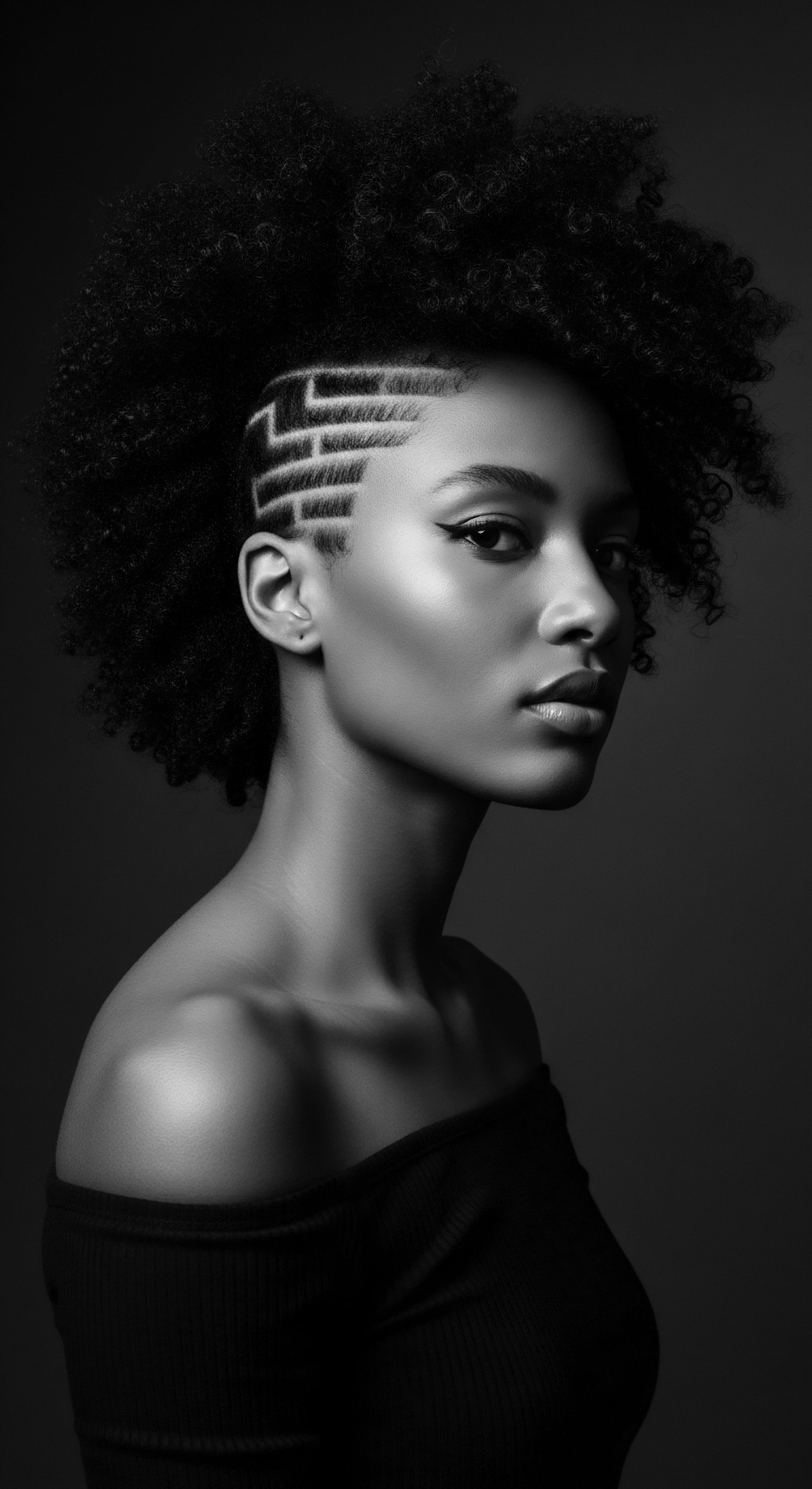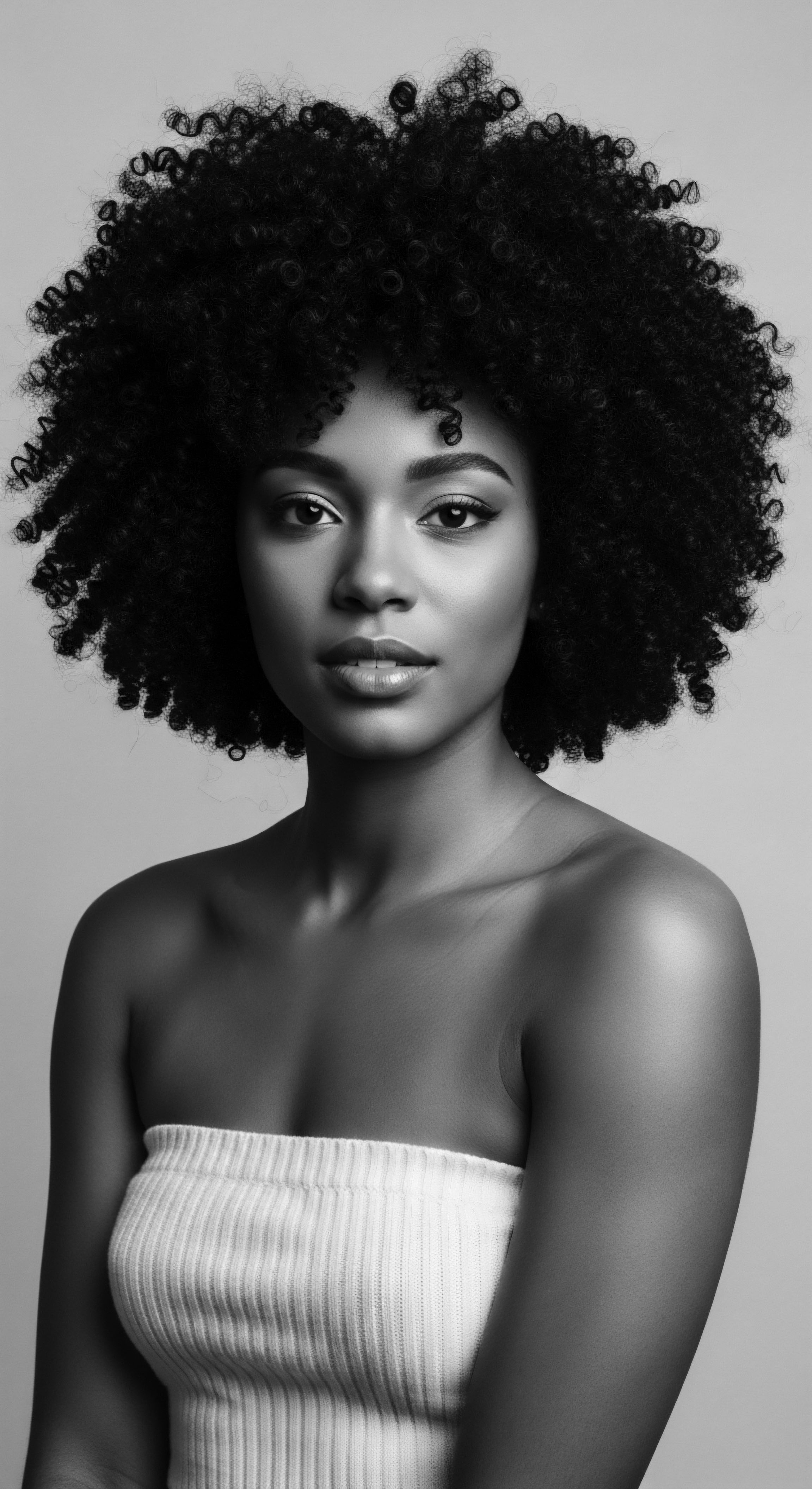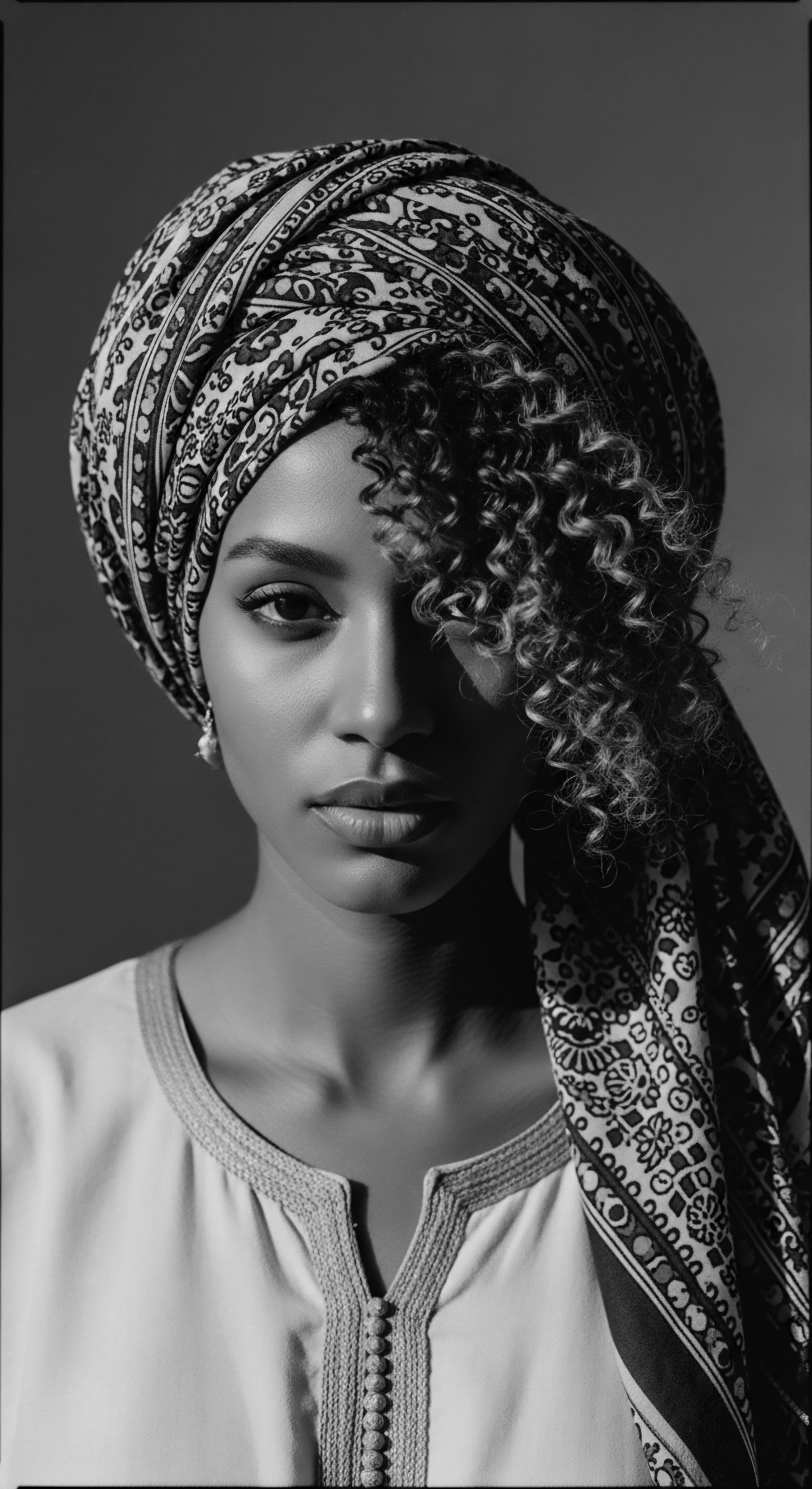
Roots
Consider the deep wisdom held within each coil, each natural twist of textured hair. It carries not merely proteins and lipids, but generations of ancestral stories, a living archive of care and resilience. For centuries, our forebears, particularly those across the vast landscapes of Africa and its diaspora, understood intuitively what modern science now articulates ❉ the delicate balance of moisture within textured hair. They understood that to preserve the vitality and strength of these strands, particularly those prone to dryness and breakage, protective measures were needed.
These measures, passed down through the ages, formed the basis of traditional sealing methods. The profound question, then, is not simply how these methods work, but rather why they resonate so deeply, reaching into the very core of textured hair’s unique structure and its ancestral memory. This journey requires us to look back, to the source, to uncover the elemental biology and the ancient practices that continue to guide us in nurturing the hair that crowns us.
Traditional sealing methods for textured hair are not just ancient techniques; they are a living testament to ancestral knowledge, echoing wisdom about moisture retention.

Hair’s Intrinsic Design and Cultural Meaning
Textured hair, characterized by its coiled or kinky patterns, presents a distinct architecture. Each individual strand, viewed microscopically, possesses an elliptical or kidney-shaped follicle, which dictates its curled formation. This intricate structure, while a symbol of remarkable beauty, means that the hair’s natural oils, known as sebum, struggle to travel down the length of the strand, leaving mid-lengths and ends susceptible to dryness. Furthermore, the cuticle, the outermost protective layer of the hair shaft, with its overlapping scales, can be more prone to lifting or separating at the bends of each curl.
This anatomical reality significantly influences hair’s porosity, its ability to absorb and retain water. When cuticles are raised, moisture enters readily but also escapes with equal swiftness, a state known as high porosity. Conversely, low porosity hair, with its tightly closed cuticles, resists moisture entry but holds onto it once absorbed. The diverse phenotypes of African descent hair, from loose waves to tight coils, present a spectrum of porosity levels.
Beyond biology, hair held immense cultural weight in ancestral African societies. It was a language, a marker of identity, status, marital status, age, and even spirituality. Hair-styling was a communal act, strengthening familial and community bonds, a practice that transcended mere aesthetics to become a fundamental social ritual.
Traditional hair care practices, often performed in a collective setting, reinforced these cultural ties. These practices, then, were not arbitrary; they were deeply rooted in a holistic understanding of hair’s needs within specific environmental contexts and cultural frameworks.

What Did Ancient Peoples Know About Hair Moisture?
While the scientific terms ‘porosity’ or ‘cuticle’ are modern constructs, the intuitive understanding of moisture management in hair is ancient. For countless generations, communities in regions with hot, dry climates, such as parts of West Africa, learned through observation and practice which natural ingredients offered genuine protection against desiccation. They recognized that certain plant-derived butters and oils could create a barrier, shielding the delicate strands from environmental elements and helping them retain hydration. This knowledge was experiential, passed from elder to youth, embedded within the fabric of daily life and ceremonial customs.
The adaptation of tightly coiled hair itself is believed to be an evolutionary response to intense solar radiation and heat, aiding thermoregulation by allowing air circulation near the scalp. This biological predisposition for dryness, coupled with the environmental realities, compelled early communities to develop intelligent solutions for moisture preservation. The practice of oiling, for instance, is documented as far back as thousands of years ago in various cultures, including those in West Africa, where oils and butters kept hair moisturized in harsh climates.
| Hair Structure Aspect Hair Follicle Shape |
| Ancestral Understanding and Cultural Lens Though not scientifically named, the visible curl pattern dictated styling methods and identified tribal affiliation or social standing. The inherent coil was understood as a blessing, a unique mark of identity. |
| Hair Structure Aspect Cuticle Layer (Porosity) |
| Ancestral Understanding and Cultural Lens Observed dryness and brittleness indicated a need for moisture retention, leading to the application of plant-derived emollients. Practices addressed hair's tendency to lose moisture, even if the precise mechanism was unknown. |
| Hair Structure Aspect Sebum Distribution |
| Ancestral Understanding and Cultural Lens Recognized that natural oils struggled to reach hair ends, necessitating external application of fats and oils for lubrication and shine, contributing to hair's vibrancy and overall healthy appearance. |
| Hair Structure Aspect The intricate dance between hair's natural characteristics and its surrounding environment led to time-honored practices, reflecting deep ancestral wisdom. |

Ritual
Traditional sealing methods, far from being simplistic applications, comprised intentional rituals, deeply woven into the cultural fabric of communities. These practices were not merely about preserving moisture; they were expressions of care, connection, and a profound respect for the hair as a symbol of self and heritage. The efficacy of these methods in aiding textured hair’s porosity stems from their deliberate design, which aligns remarkably with contemporary scientific understanding of moisture retention.

How Do Traditional Sealing Methods Work with Hair Porosity?
At its core, hair sealing involves coating the hair shaft with a substance that creates a barrier, thereby slowing down the evaporation of water. For textured hair, which, due to its unique structure, often experiences rapid moisture loss (particularly high porosity hair), this barrier is a safeguard. Traditional sealing agents, predominantly natural butters and oils, are occlusives or emollients.
Occlusives work by forming a physical layer on the hair’s surface, preventing water from escaping. Emollients, on the other hand, smooth the hair’s surface and help fill in any gaps in the cuticle, reducing moisture escape and improving flexibility.
Consider the historical use of shea butter. Harvested from the Vitellaria paradoxa tree in West Africa, shea butter has been used for centuries, possibly millennia, as a daily essential for skin and hair care. Its richness in fatty acids, including stearic and oleic acids, allows it to create a protective seal on the hair strand.
When applied after water, or a water-based moisturizer, it locks in the hydration, addressing the challenge of high porosity hair which readily absorbs water but quickly loses it. The traditional application, often on damp hair, maximized this effect, ensuring water was present to be sealed in.
Another historical example comes from Central Africa, where Chadian women have used Chébé Powder for thousands of years as an ancestral ritual for length retention and strength. This unique seed, mixed with other ingredients and applied to braided hair, contains fatty acids that aid in sealing moisture within the hair shaft, preventing dryness and brittleness. The practice of applying this mixture to braided hair also speaks to the protective styling element, further safeguarding the sealed moisture.

The Sacredness of Application Rituals
The physical act of applying these sealing agents was often more than a utilitarian task. It was a ritual, a moment of connection and care. In many African cultures, communal grooming sessions were significant social events, strengthening familial and community bonds.
Mothers, aunts, and sisters would meticulously apply butters and oils, detangle, and style hair, passing down not only the techniques but also the deeper cultural significance of these practices. This shared experience underscored the intrinsic value of hair and its care within the collective heritage.
This tender application allowed for thorough distribution of the sealing agents, ensuring each strand received its protective layer. The warmth of hands, the gentle manipulation, all contributed to the effectiveness, helping the natural fats to spread evenly and form a continuous barrier. This mindful approach to hair care, contrasting sharply with hurried modern routines, allowed for greater product penetration and overall conditioning, reinforcing the hair’s natural defenses against moisture loss.
The historical use of natural butters and oils as sealing agents for textured hair reflects an ancient understanding of occlusives and emollients, crucial for moisture retention.
The deep integration of these methods into cultural life meant that they were not just remedies for dryness, but proactive measures to maintain hair’s health and beauty. The emphasis on sustained hydration through sealing enabled hair to remain pliable, strong, and less prone to breakage, supporting its ability to grow longer and healthier over time. This cultural emphasis on healthy hair, often tied to symbols of fertility and strength, directly informed the diligent application of these sealing practices.

How Did Ingredients Inform Sealing Practices?
The choice of ingredients for sealing was inherently tied to regional availability and ancestral knowledge of their properties.
- Shea Butter ❉ Extracted from the nuts of the shea tree, native to the Sahel region, its widespread use for centuries is a testament to its protective qualities, especially in dry climates.
- Cocoa Butter ❉ Often found in regions with cacao cultivation, its rich, emollient nature made it a valued ingredient for sealing moisture, particularly in Caribbean communities.
- Plant Oils ❉ Various regional plant oils, such as palm oil, coconut oil (in some parts of the diaspora), and indigenous seed oils, were utilized for their lubricating and barrier-forming properties. These oils, along with butters, were often infused with herbs to compound their benefits.
The careful selection of these natural, fatty substances, paired with water or water-based infusions, laid the groundwork for effective moisture retention. The wisdom was in understanding that water provided the hydration, and the oils or butters kept it from escaping, a fundamental principle of effective sealing.

Relay
The continuity of traditional sealing methods, stretching from ancient African kingdoms to contemporary textured hair care, represents a remarkable relay of ancestral wisdom. Modern scientific inquiry, rather than displacing these practices, often provides a deeper validation for their efficacy, connecting elemental biology with deeply rooted cultural heritage. The interplay of hair morphology, environmental adaptation, and conscious care defines why these time-honored methods continue to serve textured hair’s porosity with such remarkable success.

What is the Science Behind Cuticle Layer Function and Sealing?
Hair porosity, the hair’s ability to absorb and hold water, is primarily governed by the integrity of the cuticle layer, the outermost protective sheath of the hair strand. This layer consists of overlapping, scale-like cells, much like shingles on a roof. In textured hair, particularly those with tighter curl patterns, the natural bends and twists of the hair shaft can cause the cuticle scales to lift or become unevenly distributed. This structural characteristic can make textured hair more susceptible to damage and, crucially, to moisture loss.
When the cuticle is raised or compromised, hair becomes more porous, readily taking in water but allowing it to escape just as quickly. This constant cycle of absorption and loss leads to chronic dryness, frizz, and increased vulnerability to breakage. Traditional sealing methods intervene in this cycle by introducing substances that either lay flat the cuticle scales or form a hydrophobic barrier.
Natural butters and oils, rich in saturated and monounsaturated fatty acids, possess molecular structures that allow them to coat the hair shaft effectively. Research highlights ingredients like shea butter, which has high concentrations of long-chain fatty acids, as effective occlusives. These lipids physically fill the microscopic gaps within raised cuticles and create a surface layer that resists water evaporation. The concept of “sealing” is essentially about establishing a sustained lipid barrier to maintain the hair’s internal hydration.
This is analogous to how the natural F-Layer (18-methyleicosanoic acid) on virgin hair acts as a hydrophobic coating, repelling water and aiding moisture retention. Traditional sealants, therefore, act as a compensatory mechanism, especially for hair that might have a compromised F-layer due to environmental factors or general wear.

How Does Ancestral Adaptation Inform Modern Care for Hair Porosity?
The very evolution of afro-textured hair is believed to be an adaptation to the intense sun and heat of ancient African climates. Its coiled structure provided insulation and airflow, protecting the scalp from solar radiation. While this was a biological advantage, it also meant that hair’s natural oils faced a greater challenge traversing the coiled path to moisturize the full length of the strand. This inherent predisposition to dryness, therefore, made moisture retention a critical factor for hair health and survival in those environments.
This ancestral reality explains the deep historical reliance on external moisturizers and sealants. The communities did not just observe hair dryness; they adapted their care practices to counter this environmental challenge. The practice of applying oils and butters was a response to a physiological need, a direct link between biological adaptation and human ingenuity in self-care. This historical context shapes the very foundation of modern textured hair care, where moisture management remains paramount.
Traditional sealing methods create a lipid barrier on hair, mimicking the natural F-layer, thereby mitigating moisture loss inherent to textured hair’s unique structural and environmental adaptations.
A study by Daphne Gallagher, published in the Journal of Ethnobiology, reveals the deep antiquity of shea butter use, demonstrating that communities in western Burkina Faso were processing shea nuts as far back as A.D. 100. This archaeological evidence points to a sustained, millennia-long understanding of shea butter’s protective qualities, affirming its cultural and practical significance in mitigating the environmental challenges faced by textured hair. This deep historical engagement underscores how indigenous knowledge systems meticulously developed effective strategies for hair care, long before contemporary scientific categorization.

Understanding Different Porosity Needs with Traditional Methods
The traditional understanding of hair’s “behavior” also subtly addressed varying porosity levels. While scientific classifications like “low” and “high” porosity are recent, anecdotal observations would have guided the choice and frequency of sealing agents.
- High Porosity Hair ❉ For hair that quickly absorbed water but dried just as fast, heavier butters and thicker oils would have been favored to provide a more robust, lasting seal. The consistent application of these agents was a practical solution to a visibly apparent challenge.
- Low Porosity Hair ❉ For hair that resisted moisture but held it well once hydrated, lighter oils or more diluted applications might have been used, possibly in combination with methods to temporarily open the cuticle, such as warmth from the sun or steam, to allow initial hydration. This intuitive adjustment ensured moisture could enter before being sealed.
The communal aspect of hair care also served as a shared repository of this practical knowledge. Elders would impart wisdom on which plants and methods worked best for different hair responses, effectively teaching a nuanced approach to porosity management without ever using the term itself. This collective learning ensured that optimal care strategies were transmitted across generations, adapting to individual and environmental specificities within the cultural context.

Reflection
The journey into why traditional sealing methods aid textured hair porosity leads us back to the very soul of a strand ❉ a profound narrative of survival, adaptation, and beauty. These time-honored practices, born from a deep, intuitive dialogue with the natural world and the unique characteristics of textured hair, stand as luminous testaments to ancestral wisdom. They remind us that the quest for healthy, vibrant hair is not a modern invention, but an enduring legacy, a whisper of resilience passed down through generations.
The understanding of how plant-derived butters and oils could create a protective barrier against the elements, preserving the hair’s precious moisture, was not an academic pursuit, but a vital aspect of life. It was a practice rooted in the fundamental need to protect and honor what was often perceived as a spiritual crown, a symbol of identity in the face of immense historical challenges. This heritage of care, woven into the fabric of daily rituals and community bonding, transcends mere cosmetic application. It speaks to a holistic approach to wellbeing, where the health of hair was intrinsically linked to cultural pride and self-preservation.
As we stand in the present, armed with scientific insights into cuticle structure and lipid barriers, we can only gaze with reverence upon the ingenious methods of our ancestors. Their understanding, refined through centuries of observation and communal practice, provided effective solutions for porosity challenges long before the advent of microscopes or chemical analyses. The traditional sealing methods serve as a powerful reminder that the deepest truths about caring for textured hair are often found in the echoes of our past, beckoning us to listen, to learn, and to carry forward a heritage of soulful care.

References
- Byrd, A. and Tharps, L. (2014). Hair Story ❉ Untangling the Roots of Black Hair in America. St. Martin’s Press.
- Evans, T. (2008). The Relationship Between Hair Porosity and Hair Care Practices. Journal of Cosmetic Science, 70(4), 205-215.
- Gallagher, D. (2016). The Archaeology of Shea Butter. Journal of Ethnobiology, 36(1), 16-32.
- Johnson, L. et al. (2020). Genetic Factors Influencing Hair Texture and Porosity in African American Women. Journal of the American Academy of Dermatology, 83(1), 101-109.
- Partee, J. (2019). The Science of Hair Porosity. Journal of the Society of Cosmetic Chemists, 70(4), 205-215.
